Standard Vanguard
| Standard Vanguard | |
|---|---|
|
1951 Standard Vanguard Phase I Saloon | |
| Overview | |
| Manufacturer | Standard Motor Company |
| Production | 1947–1963 |
| Assembly |
United Kingdom Australia New Zealand (Motor Assemblies)[1] |
| Chronology | |
| Predecessor | Standard Fourteen |
| Successor | Triumph 2000 |
The Standard Vanguard is a car which was produced by the Standard Motor Company in Coventry, England from 1947 to 1963.
The car was announced in July 1947, was completely new, with no resemblance to the previous models, and, designed in 1945,[2] it was Standard's first post-Second World War car and intended for export around the world. It was also the first model to carry the new Standard badge, which was a heavily stylised representation of the wings of a griffin.[3]
In the wake of the Second World War many potential customers in the UK and in English-speaking export markets had recently experienced several years of military or naval service, therefore a car name related to the British Navy carried a greater resonance than it would for later generations. The name of the Standard Vanguard recalled HMS Vanguard, the last of the British Navy's battleships, launched in 1944 amid much media attention, permission to use the name involved Standard in extensive negotiations with senior Royal Navy personnel.
The styling of the car was intentionally modelled on the 1942 Plymouth (and rear view).[4] although the Russian media claimed that the styling of the Vanguard had been in part influenced by Russian GAZ-M20 Pobeda, which had been in development from 1943 and went into production in 1946. In 1952 The Motor magazine stated that the Soviet Pobeda "shows a certain exterior resemblance to the Standard Vanguard", disregarding the fact that the Pobeda had been launched a year before the Vanguard.[5]
Although it is often said the styling resembled a Plymouth, that car was not slab-sided like the Vanguard, and the style of the Russian car is nearer the mark. Walter Belgrove was responsible.[6] Early cars had deep doors that blended into the bottom of the sills.
The Vanguard was first exhibited to the public at the Brussels Motor Show in February 1948.[7] It began to come off the assembly lines in the middle of 1948 but all production was allotted to the export trade.[8] An estate car and a utility pick up version were announced in September then a 12 cwt delivery van.[9] Aprons were fitted over the Vanguard's rear wheels from September 1949.[10]
Later cars had shallower doors. In 1950[11] along with the Triumph Renown it was the first car to be fitted with a Laycock de Normanville clutchless overdrive controlled from the gearlever. The Phase 2 car was available with the Laycock overdrive that operated on the second and third gears of the three-speed transmission, creating, in effect, a five-speed gearbox.
In Scandinavia, Standard marketed the Standard Ten saloon as the "Vanguard Junior".
Vanguard Phase I
| Standard Vanguard Phase I | |
|---|---|
 Standard Vanguard Phase I Saloon | |
| Overview | |
| Production |
1947–1953 174,799 made |
| Designer | Walter Belgrove |
| Body and chassis | |
| Body style |
4-door saloon 4-door estate car[12] 2-door coupe utility (Australia) 2-door van [13] |
| Powertrain | |
| Engine | 2,088 cc (127.4 cu in) Standard "four" I4 |
| Transmission |
Three speed manual Overdrive optional from 1950. |
| Dimensions | |
| Wheelbase | 94 in (2,388 mm)[14] |
| Length | 166 in (4,216 mm)[14] |
| Width | 69 in (1,753 mm)[14] |
| Height | 64 in (1,626 mm)[14] |
Chassis and running gear
The car used a conventional chassis on which was mounted the slab sided body. The chassis was later used by the Triumph 2000 roadster. Suspension was independent at the front with coil springs, and a live axle and leaf springs at the rear. Front and rear anti-roll bars were fitted. The brakes were hydraulic with 9-inch (228 mm) drums all round, and to make the most of the interior space a column gear change was used initially on the right of the steering wheel then later on the left.
Engine
The same wet liner engine was used throughout the range until the advent of the Six model in 1960, and was an overhead-valve unit of 85 mm (3.3 in) bore and 92 mm (3.6 in) stroke with single Solex downdraught carburettor. The compression ratio was 6.7:1. Wet cylinder liners were fitted. The engine was essentially the same as that made by Standard for the Ferguson tractor, with some changes for automobile use.
Transmission
At first, the transmission included a three-speed gearbox with synchromesh on all forward ratios, controlled using a column-mounted lever. The option of Laycock-de-Normanville overdrive was announced at the end of 1949 and became available in June 1950, priced for UK buyers at slightly under £45 including purchase tax.[15] Laycock overdrives were cable operated on top gear until 1954 when an electric solenoid was added.
Broadening the range of available bodies
An estate car joined the range in 1950 and, for Belgium only, some convertibles were made by the Impéria coach-building company.
Road test data
A car tested by The Motor magazine in 1949 had a top speed of 78.7 mph (126.7 km/h) and could accelerate from 0–60 mph (97 km/h) in 21.5 seconds. A fuel consumption of 22.9 miles per imperial gallon (12.3 L/100 km; 19.1 mpg-US) was recorded. The test car cost £671 including taxes.[14]
Commercial
In line with the post-war British export drive, virtually the total output was exported for the first two years of production and only in 1950 did significant home market deliveries start. The Vanguard was intended to achieve export sales, with a particular focus on Australia. During the immediate post-war period, cars were in short supply, creating a "seller's market". Restricted availability of the Vanguard helped attract willing buyers.
Closer to home, in the slowly recovering West German market the Standard Vanguard recorded 405 sales in 1950, making it the country's third most popular imported automobile, in a list otherwise featuring much smaller cars from French and Italian manufacturers. In fact, the Vanguard sales in 1950 accounted for more than 70% of the British cars sold in West Germany that year, customers of other UK manufacturers having reportedly been caught out in the late 1940s by the lack of a dealer network and difficulties in obtaining replacement parts.[16]
.jpg) Standard Vanguard Phase I Saloon
Standard Vanguard Phase I Saloon.jpg) Standard Vanguard Phase I Coupe Utility
Standard Vanguard Phase I Coupe Utility.jpg) Standard Vanguard Phase I Convertible by Imperia of Belgium
Standard Vanguard Phase I Convertible by Imperia of Belgium
Phase IA - 1952 facelift
The body was updated in 1952 with a lowered bonnet line, a wider rear window and a new grille featuring a wide horizontal chrome bar in place of the narrow, more closely packed slats of the original grille.[17] This became known as the Phase 1A.[13]
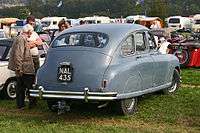 Standard Vanguard Phase 1A Saloon
Standard Vanguard Phase 1A Saloon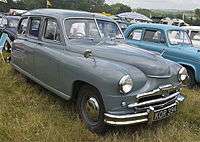 Standard Vanguard Phase 1A Estate
Standard Vanguard Phase 1A Estate- Standard Vanguard Phase 1A Pickup
Vanguard Phase II
| Standard Vanguard Phase II | |
|---|---|
 Standard Vanguard Phase II Saloon | |
| Overview | |
| Production |
1953–1956 81,074 made |
| Body and chassis | |
| Body style |
4 door saloon 2 door estate car[12] 4 door estate car[12] 2 door coupe utility (Australia) 2 door panel van [18] |
| Powertrain | |
| Engine |
2088 cc Straight-4 2092 cc Straight 4 Diesel |
| Transmission |
Three speed manual Overdrive optional. |
| Dimensions | |
| Wheelbase | 94 in (2,400 mm)[19] |
| Length | 168 in (4,300 mm)[19] |
| Width | 69 in (1,800 mm)[19] |
The Swiss importer for the Vanguard was an energetic firm called AMAG, which later took on the Swiss Volkswagen franchise. AMAG themselves assembled the Swiss market Phase I Vanguards,[17] and it was at the Geneva Motor Show in March 1953[19] that an extensive re-design was unveiled: the Phase II Vanguard was of a contemporary Ponton three-box "notch-back" design. Boot/trunk capacity increased by 50% in comparison to that of the Phase I, and visibility was improved with a further enlarged rear window.[17] A new, extended, grille now encompassed the parking lights.[13]
Mechanically there were few changes, but the clutch changed from cable to hydraulic operation and the engine compression ratio increased to 7.2:1. The previously fitted anti-roll bar was no longer used. Wider 6.00x16 tyres were fitted to improve road holding.
A car that was tested by The Motor magazine, without the optional overdrive, had a top speed of 80 mph (130 km/h) and could accelerate from 0–60 mph (97 km/h) in 19.9 seconds. A fuel consumption of 23.5 miles per imperial gallon (12.0 L/100 km; 19.6 mpg-US) was recorded.[19]
In February 1954 Standard became the first British car maker to offer a diesel engine as a factory fitted option.[20] The chassis was stiffened to take the weight of the heavier engine and performance suffered with 65 mph (105 km/h) about the top speed. Like the petrol engines, the diesel was a Standard-built "20C" engine developed for the Ferguson tractor. The diesels fitted to the tractor were restricted to 2200 rpm and developed 25 horsepower (19 kW), but road-going engines in Vanguards had no limiter and so produced 60 horsepower (45 kW) at 3800 rpm. However, they retained the tractor's "Ki-Gass", de-compressor and over-fuelling systems, all of which had to be manually operated when starting the engine from cold. 1,973 diesel Vanguards were made.
In 1954 The Motor magazine tested the diesel version and recorded a top speed of 66.2 mph (106.5 km/h) acceleration from 0–50 mph (80 km/h) in 31.6 seconds and a fuel consumption of 37.5 miles per imperial gallon (7.5 L/100 km; 31.2 mpg-US). The test car, which had overdrive, cost £1099 including taxes.[21]
For 1955, the Australian-built coupé utility was given a re-styled tail which resulted in extra room in the cargo area.[13] It also featured a new full-width rear window and improved cabin features.[13] As the coupe utility variant of the Phase III style was not yet available, an updated Phase II utility was offered in 1956 with a mesh grille, two-tone paint and new interior trim.[13]
 Standard Vanguard Phase II Estate
Standard Vanguard Phase II Estate.jpg) Standard Vanguard Phase II Utility
Standard Vanguard Phase II Utility.jpg) Standard Vanguard Phase II Saloon
Standard Vanguard Phase II Saloon
Vanguard Phase III, Sportsman and Ensign
| Standard Vanguard Phase III Standard Vanguard Sportsman Standard Ensign | |
|---|---|
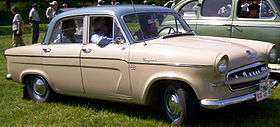 Standard Vanguard Phase III Saloon | |
| Overview | |
| Production |
1955–1958 37,194 Phase III, 901 Sportsman, 18,852 Ensign and 2318 Ensign de-luxe made[20] |
| Body and chassis | |
| Body style |
4 door saloon 4 door estate car 2 door coupe utility (Australia) |
| Powertrain | |
| Engine |
2088 cc Straight-4 (Phase III) 1670 and 2138 cc (Ensign) |
| Transmission |
Four speed manual Overdrive optional automatic from 1957. |
| Dimensions | |
| Wheelbase | 102.5 in (2,604 mm)[22] |
| Length | 172 in (4,369 mm)[22] |
| Width | 67.5 in (1,714 mm)[22] |
| Height | 61.5 in (1,562 mm)[22] |
The Phase III, released to the market for the mid-October 1955 Earls Court Motor Show,[23] was a radical change with the elimination of the separate chassis. There was an overlap in availability of the old model with the Phase II estate continuing into 1956.
UK fuel was no longer restricted to the 72 octane "Pool petrol" of the 1940s and early 1950s, and with the modest increases in available octane levels, the Vanguard's compression ratio was increased to 7.0:1. The 2088 cc engine with its single Solex downdraught carburettor now produced 68 bhp (51 kW; 69 PS).
The front suspension was independent, using coil springs, and was bolted to a substantial sub-frame which also carried the recirculating ball steering gear. Semi-elliptic leaf springs were used on the rear axle. Lockheed hydraulic brakes with 9 in (229 mm) drums were fitted front and rear. The three-speed gearbox had a column change and the optional overdrive was operated by a switch on the steering column. A four-speed floor change became an option.
The new body was lower and had an increased glass area, making it look much more modern, and the old two-piece flat windscreen gave way to a one-piece curved design. The wheelbase increased by 8 in (203 mm), giving much better passenger accommodation. A heater was now a standard fitting. Bench seats were fitted in front and rear with folding centre arm rests. They were covered in Vynide, with leather available as an option.
The car was lighter than the superseded model, and the gearing was changed to deliver better economy with performance virtually unchanged.
A car with overdrive was tested by the British magazine The Motor in 1956. It had a top speed of 83.7 mph (134.7 km/h), could accelerate from 0–60 mph (97 km/h) in 21.7 seconds and had a fuel consumption of 25.9 miles per imperial gallon (10.9 L/100 km; 21.6 mpg-US). The test car cost £998 including taxes.[22]
For 1957, the Australian-produced Phase III was given a facelift with a new mesh grille.[13] In addition the sedan now sported fins on the rear guards.[13]
Vanguard Sportsman
A performance model, the Vanguard Sportsman, intended to be badged as the Triumph Renown until shortly before launch, was announced in August 1956[6] with a tuned 90 bhp (67 kW; 91 PS)[6] engine having similar features to the Triumph TR3 sports car. These included an increased compression ratio to 8.0:1, twin SU carburettors,[24] and improved pistons. However, the Sportsman's inlet manifold and carburettors sat at a different angle from those of the TR3, and its engine had the same 85 mm bore as the Vanguard's,[24] not the 83 mm bore of the TR3.[25] The final-drive ratio was lowered to 4.55:1 to give better acceleration, and larger 10 in (254 mm) drums fitted to the brakes. The standard version had a bench front seat but separate seats were an option.
Although sharing the same basic body shell with the other Vanguard variations, the Sportsman had design variations, including a squarer front grille, which gave the car a slightly higher, squarer appearance than the regular models.[6]
Just 901 examples of the Sportsman model were made up to 1958.[20] Sportsmans then became available to special order, and around another fifty (mostly estate cars) were built between 1958 and 1960. A small number were built before the Vignale makeover in 1958. Popular Classics magazine's test of a Sportsman in 1994 stated that a total of 962 were built.[6]
A Sportsman with overdrive was tested by the British magazine The Motor in 1956 and it recorded a top speed of 90.7 mph (146.0 km/h), acceleration from 0–60 mph (97 km/h) in 19.2 seconds and a fuel consumption of 25.6 miles per imperial gallon (11.0 L/100 km; 21.3 mpg-US). The test car cost £1231 including taxes.[26]
Standard Ensign
A basic model, the Ensign, with 1670 cc engine,[27] was announced in October 1957 restyled by Michelotti. The Ensign shared its body with the Vanguard Series III, but had a cheapened specification in various respects, including a mesh front grille and a simplified instrument panel and dashboard. Despite the generally lower specification, the Ensign was the first Vanguard-based car to have a four-speed gearbox. The gear lever was moved from the column to the floor, and overdrive was optional. Many were bought for company fleets and for the armed forces.[28] 18,852 were made in total.[20] A DeLuxe version followed in 1962 and 1963 with a larger 2138 cc engine. Unlike the smaller-engined original version, the DeLuxe was also available as an estate car.[24]
A 1670 cc Ensign was tested by the British magazine The Motor in 1958. It recorded a top speed of 77.6 mph (124.9 km/h), acceleration from 0–60 mph (97 km/h) in 24.4 seconds and a fuel consumption of 28.5 miles per imperial gallon (9.9 L/100 km; 23.7 mpg-US). The test car cost £899 including taxes of £300.[29]
In January 1960 a Diesel engined Ensign was announced, featuring the compact "P4C" 1.6 litre four-cylinder engine produced by specialists Perkins of Peterborough.[30] Claimed output was 43 bhp (32 kW), with fuel consumption stated as "about 50 mpg" (5.6 L/100 km; 42 mpg-US).[30] Those values, given the size of the car, suggest relatively modest top speed and acceleration figures.
.jpg) Standard Vanguard Phase III Saloon
Standard Vanguard Phase III Saloon.jpg) Standard Vanguard Sportsman
Standard Vanguard Sportsman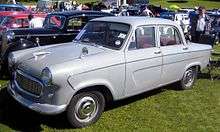 Standard Ensign Saloon
Standard Ensign Saloon Standard Ensign Estate
Standard Ensign Estate
Vanguard Vignale
| Standard Vanguard Vignale | |
|---|---|
 | |
| Overview | |
| Production |
1958–1961 26,267 made[20] |
| Designer | Giovanni Michelotti |
| Body and chassis | |
| Body style |
4 door saloon 4 door estate car 2 door coupe utility (Australia) [31] 2 door panel van [32] |
| Powertrain | |
| Engine | 2088 cc Straight-4 |
| Transmission |
Four speed manual Overdrive optional automatic |
| Dimensions | |
| Wheelbase | 102 in (2,591 mm)[29] |
| Length | 172 in (4,369 mm)[29] |
| Width | 68.5 in (1,740 mm)[29] |
| Height | 60 in (1,524 mm)[29] |
A face-lift of the Phase III was designed by Italian stylist Giovanni Michelotti and coach-builders Vignale in 1958, and was introduced at the October 1958 Earls Court Motor Show.[33] The windscreen and rear window were deeper, and there was a revised grill and trim. A floor change four-speed manual gearbox was now fitted, and the provision of a three-speed gear box with column change offered as an option. An overdrive was also offered an option, as was an automatic. One automatic car is known to have survived - there may be others.
The car had front and rear bench seats, which were covered, as standard, in Vynide. Leather was an option on the home market and cloth for exported models. A heater and (unusual for the time) electric windscreen washers were factory fitted, although a radio remained an option.
A Vignale with overdrive was tested by the British magazine The Motor in 1959. It recorded a top speed of 82.8 mph (133.3 km/h), acceleration from 0–60 mph (97 km/h) in 20.8 seconds and a fuel consumption of 28.0 miles per imperial gallon (10.1 L/100 km; 23.3 mpg-US). The test car cost £1147 including taxes of £383.[34]
- Standard Vanguard Vignale Saloon
.jpg) Standard Vanguard Vignale Estate
Standard Vanguard Vignale Estate.jpg) Standard Vanguard Vignale Utility
Standard Vanguard Vignale Utility
Vanguard Six
| Standard Vanguard Six | |
|---|---|
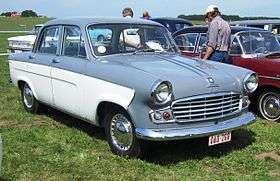 | |
| Overview | |
| Production |
1960–1963 9953 made |
| Designer | Giovanni Michelotti |
| Body and chassis | |
| Body style |
|
| Powertrain | |
| Engine | 1998 cc Triumph "Six" I6 |
| Transmission |
Three or four-speed manual Overdrive optional automatic |
| Dimensions | |
| Wheelbase | 102 in (2,591 mm)[35] |
| Length | |
| Width | 67.5 in (1,714 mm)[36] |
| Height | 60 in (1,524 mm)[35] |
Introduced at the end of 1960, the last of the Vanguards featured a six-cylinder 1,998 cc engine with push-rod overhead valves: this was the engine subsequently installed in the Triumph 2000. The compression ratio was 8.0:1, and twin Solex carburettors were fitted giving an output of 80 bhp (60 kW) at 4500 rpm.[35] Externally the only differences from the Vignale were the badging but the interior was updated.
Australian production included coupe utility and van variants.[13] Early in the model run the rear lights of the coupe utility were changed from a vertical to a horizontal layout with a different rear body side panel.[13]
A Vanguard Six was tested by the British magazine The Motor in 1960. It recorded a top speed of 87.2 mph (140.3 km/h), acceleration from 0–60 mph (97 km/h) in 17.0 seconds and a fuel consumption of 24.9 miles per imperial gallon (11.3 L/100 km; 20.7 mpg-US). The test car cost £1021 including taxes of £301.[35]
.jpg) Standard Vanguard Six Saloon
Standard Vanguard Six Saloon- Standard Vanguard Six Estate
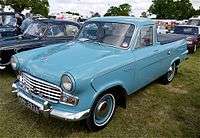 Standard Vanguard Six Utility (later version with horizontal rear lights)
Standard Vanguard Six Utility (later version with horizontal rear lights)
Replacement and end of Standard
In 1958 Standard divested itself of Massey Ferguson and used the proceeds of the sale to develop the Triumph Herald. This left the slow-selling Vanguard as the flagship. It was a 1954 design, and was no competition for the Vauxhall Velox and Ford Zephyr. As a panic measure, the Herald was stretched and widened into a prototype Vanguard replacement. A proposal was made to American Motors to build the Rambler American under licence. Leyland Motors took over Standard-Triumph in 1960 and the prototype Triumph 2000 progressed with new money, the engine being used by the Vanguard Six from 1961 to early 1963. The six was lighter than the old four and was a development based on the Standard Ten unit.
Both the Ensign and the Vanguard were replaced in 1963 by the Triumph 2000, and the Standard name disappeared from the British market after 60 years.
Vanguard Utility
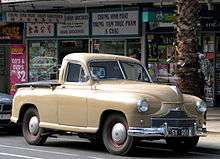
In 1950, the Australian subsidiary of the Standard Motor Company introduced a coupé utility version of the Vanguard Phase I. It was fitted with the same 2088 cc four-cylinder engine as used in the saloon.[37] Utility versions of the Vanguard were produced in Australia over the following years,[38] with production ending in 1964.[39]
The Vanguard Utility was sold in the UK as a pickup truck. The main purchaser was the Royal Air Force, which had them in Phase I and II form. The Phase II commercials remained available until 1958, when they were replaced by the Phase 3. Around 50 phase 3 pickups went to Welsh Water and the workshop manual pictures a pickup with a.body by Awson. A gown van and a breakdown tender are shown in the brochure.
Sales in the UK were modest, mostly due to stiff competition from the British Motor Corporation and from Standard's other commercial vehicles including the 5 cwt and later 7 cwt vehicles. Standard later concentrated their efforts on the forward control Atlas vehicle.
Die-Cast models
- Dinky Toys made a model of the Phase I.
- Corgi Toys included a model of the Phase III saloon in their range from 1957 to 1961 as model No 207.[40] Additionally, a Phase III saloon presented as a Royal Air Force Staff Car was available from 1958 to 1962 as model No 352.[41]
Notes
- ↑ Webster 2002, pp. 71–72.
- ↑ Standard Motor Company, Business and Finance. The Times (London, England), Monday, Nov 10, 1947; pg. 8; Issue 50914
- ↑ The Standard Car Review. January 1947. Missing or empty
|title=(help) - ↑ p.217, Michael Sedgwick, Cars of the Thirties and Forties, Hamlyn, London 1975 ISBN 0600321487
- ↑ Clarence 1952.
- 1 2 3 4 5 Rodgerson, Carl (June 1994), "High Standards", Popular Classics, pp. 87–91
- ↑ Brussels Motor Show. The Times, Saturday, Feb 14, 1948; pg. 3; Issue 50995
- ↑ News in Brief. The Times, Wednesday, Jun 02, 1948; pg. 3; Issue 51087.
- ↑ The Standard Vanguard. The Times, Thursday, Sep 23, 1948; pg. 2; Issue 51184
- ↑ Motor Show To-Day. The Times, Wednesday, Sep 28, 1949; pg. 4; Issue 51498
- ↑ An Overdrive Gear. The Times, Tuesday, Jun 06, 1950; pg. 2; Issue 51710
- 1 2 3 Sedgwick & Gillies 1993, p. 185.
- 1 2 3 4 5 6 7 8 9 10 11 12 Alan McMillan, Vanguard Spotters Guide, 2009, www.stcc.com.au, as archived at web.archive.org on 18 March 2015
- 1 2 3 4 5 "The Standard Vanguard Road Test". The Motor. 1949.
- ↑ "Standard Vanguard Saloon (with overdrive)". Autocar. 11 August 1950.
- ↑ Augstein 1951, p. 27.
- 1 2 3 Gloor 2007.
- ↑ Standard Commercial Vehicles sales brochure (brochure), retrieved 26 October 2011
- 1 2 3 4 5 "The Phase II Standard Vanguard Road Test". The Motor. 11 March 1953.
- 1 2 3 4 5 Sedgwick & Gillies 1986.
- ↑ "The Standard Diesel Vanguard". The Motor. 106 (2752). 10 November 1954.
- 1 2 3 4 5 "The Standard Vanguard III". The Motor. 109 (2830). 20 June 1956.
- ↑ New Standard Vanguard. The Times, Friday, Oct 14, 1955; pg. 4; Issue 53351
- 1 2 3 Culshaw & Horrobin 2013, p. 287.
- ↑ Culshaw & Horrobin 2013, p. 318.
- ↑ "The Standard Sportsman". The Motor. 110 (2841). 5 September 1956.
- ↑ Culshaw & Horrobin 2013, pp. 286-287.
- ↑ Robson 2011, p. 160.
- 1 2 3 4 5 "The Standard Ensign". The Motor. 107 (2913). 22 January 1958.
- 1 2 "News summary: Current events and recent announcements: New Diesel car" Practical Motorist, January 1960
- ↑ Advertisement for Standard Vanguard (Vignale) utility, Australian Motor Industries Ltd, Australian Motor Manual (magazine), 1 August 1960, page 29
- ↑ "Standard 1959". www.classiccarcatalogue.com. Archived from the original on 28 September 2013. Retrieved 26 October 2011.
- ↑ "The Standard Motor Company. Lord Tedder Describes Expansion And Development". The Times (54316). London. November 24, 1958. p. 14.
- ↑ "The Standard Vignale Vanguard". The Motor. 114 (2963). 7 January 1959.
- 1 2 3 4 5 "The Standard Vanguard Six". The Motor. 118 (3055). 7 December 1960.
- 1 2 Boddy, William (January 1961). "Impressions of two British Estate Cars". Motor Sport. p. 46.
- ↑ "Standard Introduces A Vanguard Pick-up". Australian Monthly Motor Manual: 834–835. March 1950.
- ↑ "Standard Vanguard utility images". Picture Australia. Retrieved 1 August 2008.
- ↑ "Australian History". Retrieved 26 October 2011.
- ↑ Force 1991, p. 166.
- ↑ Force 1991, p. 174.
References
- Allen, Michael (1985). British Family Cars of the Fifties. Haynes Publishing. ISBN 0-85429-471-6.
- Augstein, Rudolf (18 April 1951). Augstein, Rudolf, ed. "Angriff abgeschlagen: Mit einem einzigen Blick kann man aus der Außenhandelsstatistik 1950 ablesen, daß...." (in German). SPIEGEL-ONLINE. p. 27. Retrieved 2013-05-18.
- Clarence, I. A. S. (19 November 1952). "Impressions of the Russian POBIEDA". The Motor. 102 (2649).
- Culshaw, David; Horrobin, Peter (2013) [1974]. "Standard". The Complete Catalogue of British Cars 1895 - 1975 (e-book ed.). Poundbury, Dorchester, UK: Veloce Publishing. pp. 281–287. ISBN 978-1-845845-83-4.
- Force, Edward (1991). Corgi Toys. p. 166.
- Gloor, Roger (2007). Alle Autos der 50er Jahre 1945 – 1960 (1. Auflage ed.). Stuttgart: Motorbuch Verlag. ISBN 978-3-613-02808-1.
- Robson, Graham (May 2011). The Book of the Standard Motor Company. Poundbury, Dorchester, UK: Veloce Publishing. ISBN 978-1-845843-43-4. Retrieved 19 October 2014.
- Sedgwick, M.; Gillies, M. (1986). A–Z of Cars 1945–1970. Devon, UK: Bay View Books. ISBN 1-870979-39-7.
- Sedgwick, Michael; Gillies, Mark (1993). A to Z of Cars 1945–1970 (Revised paperback ed.). p. 185.
- Webster, Mark (2002), Assembly: New Zealand Car Production 1921-98, Birkenhead, Auckland, New Zealand: Reed, pp. 71–72, ISBN 0-7900-0846-7
- "News summary: Current events and recent announcements: New Diesel car". Practical Motorist. 6 (65): 481. January 1960.
External links
| Wikimedia Commons has media related to Standard Vanguard. |